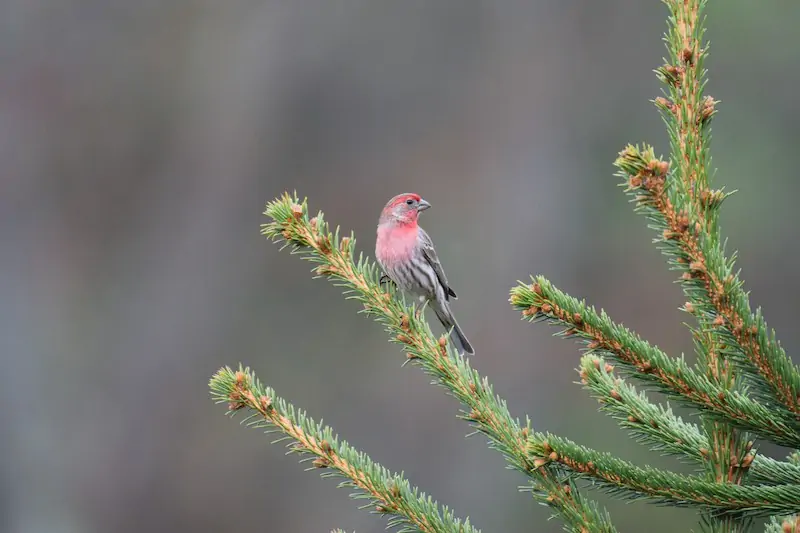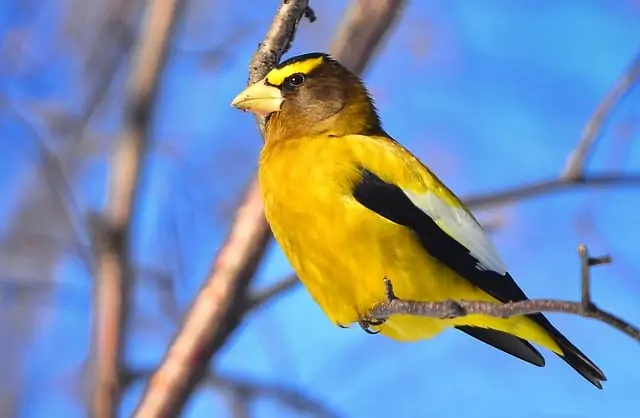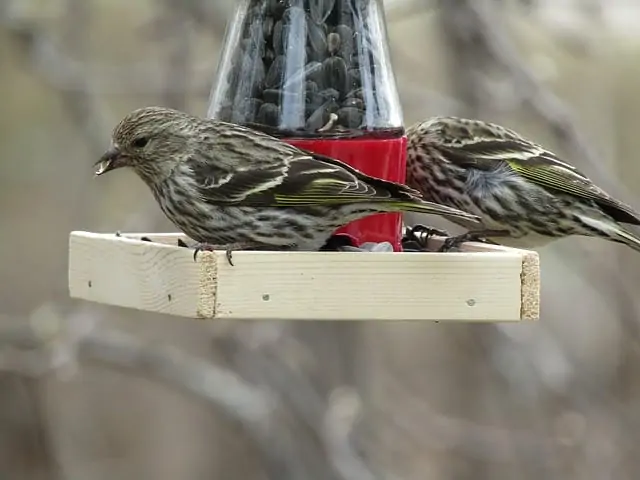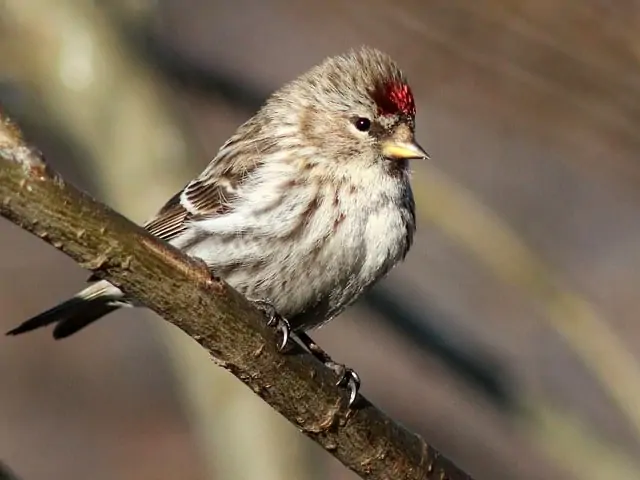Finches come in a wide variety of colors and bill sizes. They are small songbirds. These are the legendary creatures Charles Darwin studied during his voyage of the Galapagos Islands. You may recognize them. Michigan’s finches aren’t quite the same as Galapagos finches, but they do have their own unique species that are worth seeing. Read on to discover everything about the 10 kinds of finches found in the state.
THE 10 SPECIES OF FINCHES IN MICHIGAN
Finch species abound in Michigan’s biodiversity. House Finches, American Goldfinches, Evening Grosbeaks, Pine Siskins, Purple Finches, Common Redpolls, Red Crossbills, White-winged Crossbills, Hoary Redpolls and Pine Grosbeaks are among the species that live there. Several of these birds are dubbed “birds of the north.” Michigan is unique in that it is situated near the Canadian border, allowing these mostly Canadian species to be seen.
1. HOUSE FINCH

Throughout most of the United States, including Michigan, House Finches are ubiquitous birds. These finches are very adaptable and may now be found in several human-occupied regions, such as suburbs, parks, and cities. They are native to the dry deserts of the southwest but are now found throughout much of the world.
This bird’s eastern expansion, according to Audubon, can be traced back to 1940s New York petstore owners. In order to avoid getting detected, they were selling the birds illegally and releasing them into the wild. The birds, of course, flourished and are now found all across the nation.
It’s likely that you’ve seen House Finches before. With short wings and a longer tail, they have small bodies and large beaks. Males have crimson coloration on their faces and chests, while females are typically a drab brown with pale-colored streaks. Feeding in the backyard, on the ground, or in bushes and trees, they’re active feeders that are readily identifiable.
2. AMERICAN GOLDFINCH

In Michigan, American Goldfinches are found all year. These birds are widespread and can be found across much of the country. They’re also likely to visit back yard feeders, and they’ll eat whatever seed they’re given, including sunflower and nyjer seeds.
Only the cheery, bright yellow plumage of adult breeding males distinguishes them from other birds. Their singular yellow bodies with prominent, black markings on the head and wings are a favorite sight for birders throughout the spring and early summer. In the winter, however, this hue turns to a drab olive color. People mistake them for a variety of different birds on many occasions.
The tail of American Goldfinches is short and notched, with long wings. Perfect foraging seeds tools are their bills, which are solid cones that come to a point. These birds actively climb to reach the seeds of weeds and trees, demonstrating their eagerness for food.
3. EVENING GROSBEAK

These regal-looking finches, which are only seen outdoors of the breeding season, live all year at the very tip of Michigan, which is located between Lake Huron and Lake Michigan.
Evening grosbeaks are becoming increasingly rare, particularly in the eastern part of the United States. They do, however, travel south during the winter in such small numbers that there may be a lot of them at one time, taking full advantage of suburban feeders.
Evening Grosbeaks have blocky heads and robust, heavy beaks that set them apart from other finches. Their bodies are stocky, with short tails and hefty necks. Male evening grosbeaks have black edged wings with a bright patch of white in the center, and they are mostly yellow in coloration. The a distinctive look is given by their dark heads with a prominent canary-yellow eyebrow stripe.
4. PINE SISKIN

Littleer than American Goldfinches, Pine Siskins are little finches. Finches have slender, pointed bills, which are sharp and pointed. They have yellow markings on their wings and tails and are mostly covered in streaky brown plumage. Their notched tails, as well as their pointed wings, are clearly visible in flight.
Pine siskins, like evening grosbeaks, are only found in the far northern section of Michigan throughout the winter, however they may be seen across the rest of the state during summer. Pine siskins prefer coniferous woods, but will also frequent mixed woods of both evergreens and deciduous trees. Their name implies that they are fond of pine.
Pine siskins are active foragers in trees, weeds, scrublands, and bushes, and their diet is mostly seed and plant matter. They’ll also eat out of feeders, with thistle feeders appearing to be their preferred option. They’ll also consume other little seeds, however.
5. PURPLE FINCH

In a wider northern range of Michigan than pine siskins or evening grosbeaks, purple Finches can be found year-round. During the non-breeding season in winter, purple finches, like other finches, may be seen throughout the remainder of the state.
Since both sexes of both species are the same size and have reddish colors, distinguishing between a purple finch and a house finch can be challenging. Both species’ females have streaks and are mostly brown in color. Purple finches, on the other hand, have a broader range of color and a pinker hue than house finches’, with a stronger purple-red tone. In addition to a bigger beak, purple finches have a bulkier body.
Purple finches, like most foragers, are often found high in the trees searching for seeds. During the breeding season, they prefer coniferous woods, although during the winter, they expand their range to include many other types of wood. Backyard feeders with black oil sunflower seeds are also favorites of Purple Finches.
6. COMMON REDPOLL

In the United States, Redpolls are a rare sight, with only Michigan having them throughout the winter. They are, however, quite common and numerous in Canada and the Arctic, where they breed. They travel south in a disorganized manner, making it difficult to anticipate when they will move. In some cases, they’ll gather in large numbers far south of their winter range.
When it comes to foraging, Common Redpolls are energetic and active. They climb branches and stems in order to reach seeds, fluttering from place to place. They have a pouch on the inside of their throats that allows them to store food for extended periods of time, which will help them become even more proficient at collecting food.
Little finches with small heads and beaks that are tiny and pointed. They have a lot of streaking and are mostly brown and white. Males have a red patch on their foreheads, while females have red markings on their chests.
7. RED CROSSBILL

The strange, criss-crossed fractures that distinguish Red Crossbills from other finches are a unique feature for breaking into conifer cones. As a result, they are normally only found in coniferous woods. Spruces, pines, hemlock, and Douglas-firs are among the trees whose seeds they rely on.
Conifers produce a wide range of seeds, so the birds’ migration is difficult to predict due to the variance in available seeds from season to season. Regular irruptive migrations of red crossbills are observed far outside their normal range, as these nomadic birds flock to wherever food is available. These finches are mostly seen throughout the winter, despite the fact that there are limited populations at the northern tip of Michigan.
8. WHITE-WINGED CROSSBILL

The twisted beak of white-winged crossbills is identical to that of red crossbills. They, too, migrate as wanderers, much like red crossbills. Even though they only exist in Michigan during the winter, their appearances are difficult to predict. It is dependent on how many coniferous cones there are when they do migrate.
Finches of the White-winged Crossbill size range. Females are generally a brownish yellow, while adult males have a rosy-red color on their heads and chests with jet-black wings. They prefer to gather in flocks and may nest anywhere if they discover a location rich in spruce and other coniferous seeds, even if breeding season is not present.
9. HOARY REDPOLL

Although they breed in the arctic tundra, where they breed, Hoary Redpolls are only seen in Michigan during winter irruptions. They’re closely related to common redpolls, but they’re less likely to be seen.
The hoary redpoll is covered in white feathers, given its status as a bird of the snowy north. Save for a few blush-red patches on their chests, their bellies are virtually completely white. Their foreheads are brighter red, and their uppers and wings feature gray-brown streaks. The finest way to tell them apart from a common redpoll is by looking at their mostly-white chest with no streaking.
10. PINE GROSBEAK

With an average length of 8–10 inches, Pine Grosbeaks are one of the biggest of the genuine finches. Males have gray wings and white wingbars, and are a reddish-pink color overall. The olive-yellow color of females and juveniles Pine grosbeaks may be found in open evergreen woods, as the name suggests. Buds, seeds, and fruits from juniper, birch, spruce, pine, and mountain ash trees make up the majority of their diet. Backyard feeders with sunflower seeds are known to attract them.
In Canada, the majority of pine grosbeaks may be found, although there are minor populations in the United States. They’re most commonly seen in pockets of evergreens along the lakeshore in Michigan, where they’re mostly spotted along the far northern boarders. Nonetheless, in years when Canada’s boreal trees produce a lesser seed harvest, they may travel farther south for food, as compared to usual.
